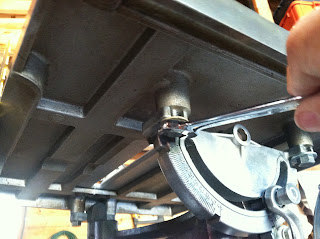It truly has been an enjoyment in restoring the Shopsmith, and even more so writing about it. There were many times that I rather forced myself to make some progress with the Shopsmith simply so that I could write the story behind it. In fact, several blog updates were independent of actual restoration work (witness Episode 14: Rusty's Letter Back Home, Episode #9: the Halfway Point & Report Card, and of course the dreaded Episode #13, which we won't mention here for obvious reasons).
I am also quite proud that the blog site was also able to provide a small public service. The blog spawned several rather lengthy threads on the Yahoo Shopsmith10ER User group about serious issues facing our small user community. For example, Episode #12 generated numerous threads about the best way to clean/restore aluminum tables; and Episode #4 where a search for a particular knurled knob launched a lengthy conversation about the benefits of local community hardware stores versus big box companies.
No need to thank me.
I am particularly pleased at the quantity of pageviews the blog received. With over 2300 pageviews at the time of this writing, it is not a runaway internet viral phenomena, but gratifying nevertheless. I am inclined to thank the one person who viewed the blog site 2300 times (probably my wife - just to make me feel good). However, the broad range of countries which viewed the site probably precludes only one reader...and being recently retired and constantly underfoot of my wife, I am pretty sure she has not been traveling to these countries over the last six months. So, maybe there were at least 12 people viewing the blog.
What I find exciting is the range of countries where we apparently have Shopsmith owners - or at least readers interested in Shopsmiths (or maybe they haven't a clue about Shopsmiths...but just like good writing!).
Below is a summary of the countries which viewed the blog site and quantity of pageviews:
- United States (including Alaska) - 1982
- Canada - 93
- Germany - 45
- Australia - 45
- Russia - 30
- United Kingdom - 15
- Israel - 11
- India - 10
- South Korea - 7
- France - 6
- Argentina
- Poland
- Romania
Although there are many sources, most readers found or accessed the blog site through three main sources:
- Google searches (looking for anything "Shopsmith")
- Facebook (thanks to my own family and close friends), and
- Yahoo Groups (i.e. the Shopmith10ERUsers) user group.
As far as Rusty goes, well I guess I cannot delay the inevitable any more, and must start thinking about using it to build something. You may recall the very first episode where Diane asked the gut wrenching question: "So what are you going to make with it once it is back together?" I still have a deer-in-the-headlights stare when the question comes up. I usually respond with some lame answer, such as "Oh probably some shelves for the garage".
Speaking of weight, it will take some time to become familiar and experienced with the operation of the machine. I found that sliding the headstock or the carriage back and forth is not as simple an operation as it would seem. These are solid, heavy pieces of machinery, and sometime require two hands to slide. Besides, you need to a) remember to unlock the carriage before trying to move it, b) remember to lower the Shopsmith to the ground so that it doesn't fly across the garage when you try and push the headstock, and c) remember to completely raise the table (or maybe even remove it) before attempting to slide the carriage as the saw blade wants to completely clear the table to make that operation successful.
There are many posts and information on user forums about lift-assist mechanisms - ones which help when raising the Shopsmith to the drill press position. When I first was working on the machine, I had to raise and lower the assembly to align the way tubes. That wasn't so bad. Then I added the motor and speed changer assemblies. It isn't too bad if the headstock and carriage are at the far right of the way tubes...but then to use the drill, you'll need to be on your knees. Moving the headstock and carriage more to the left of the machine in order to get a workable drill height when rotated up, well, a one-handed lift isn't in my future (as buff as I am).
I am quite the amateur when it comes to woodworking. A successful project is one which I walk away with all fingers and all toes (don't ask). I tend to mark my body with war wounds to prove I have done real work (and also to gain sympathy from my wife and thereby deflecting attention away from the final project reveal). Any future blog site I may write regarding my woodworking projects will, I am sure, bring both tears of sadness as well as some comic relief. Nevertheless, don't hold your breath for such a blog site soon.
The Shopsmith is primarily a woodworking machine (although not restricted to that) and hence most of us are woodworkers at various levels of capabilities. I found it rather ironic then that the restoration of Shopsmiths also requires us to be metal machinist of sorts - cleaning, grinding, scraping, wet sanding, bead blasting, painting. Thank goodness for internet user groups which are tremendously invaluable in helping in the restoration process. I particularly want to thank Skip Campbell and the Shopsmith10ERusers yahoo group for access to a boatload of technical documents, manuals, and restoration guidance.
I also want to thank my wife, Diane for her support, proofreading, and putting up with all of my craziness.




















































